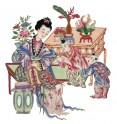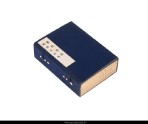Room 38 | China from AD 800 gallery
Explore key developments in the history and culture of China, from the arts and crafts of the Song Dynasty up to the present day.
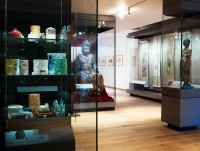
Works of art have been collected in China for more than a thousand years, though what people chose to collect has changed over time.
The earliest collections were formed by emperors, and mostly contained objects associated with their authority. The first printed catalogues of collections listed the Imperial holdings of calligraphy, paintings and ancient ritual bronzes.
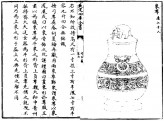 Elephant vessel from the collection of Lu Jiang, in Lu Dalin's Kaogu tu (Illustrations of Archaeolog.
Elephant vessel from the collection of Lu Jiang, in Lu Dalin's Kaogu tu (Illustrations of Archaeolog.
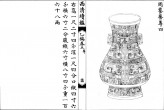 Zhou Dynasty (c.1050-221 BC) taotie vessel, number 4 in Xiqing xujian (Western Purity bronze collect.
Zhou Dynasty (c.1050-221 BC) taotie vessel, number 4 in Xiqing xujian (Western Purity bronze collect.
From around 1100 onwards, civil servants, scholars, and even successful merchants began to collect art and antiques. More and more objects became regarded as collectible, even new imitations of older pieces.
In the 1700s, the Qianlong emperor (ruled 1736-1795) brought together huge collections of calligraphy, books, paintings and antiques, and sponsored many cultural projects and craft workshops. Today, objects associated with his reign and with those of earlier emperors are the most highly valued by collectors of Chinese art.
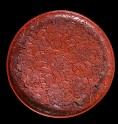 Lacquer dish with flowers (EA1981.9)
Lacquer dish with flowers (EA1981.9)
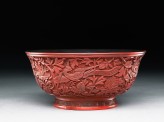 Lacquer bowl with a phoenix amid peonies (EA1964.74)
Lacquer bowl with a phoenix amid peonies (EA1964.74)
 Porcelain ewer in the form of a Tibetan monk's cap (EA1978.2073)
Porcelain ewer in the form of a Tibetan monk's cap (EA1978.2073)
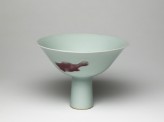 Stem cup with fish (EAX.1413)
Stem cup with fish (EAX.1413)
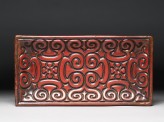 Carved lacquer tray with guri scrolling design (EA1967.138)
Carved lacquer tray with guri scrolling design (EA1967.138)
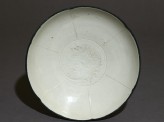 White ware bowl with lotus design (EA1956.1433)
White ware bowl with lotus design (EA1956.1433)
 Jade dish in Mughal style (EAX.2081)
Jade dish in Mughal style (EAX.2081)
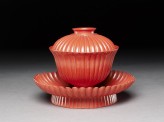 Bodiless lacquer cup and stand (EA1992.107)
Bodiless lacquer cup and stand (EA1992.107)
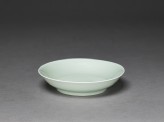 Porcelain saucer dish with celadon glaze (EAX.1516)
Porcelain saucer dish with celadon glaze (EAX.1516)
 Greenware bowl in the style of Guan ware (EA1956.1356)
Greenware bowl in the style of Guan ware (EA1956.1356)
 Greenware vase in the style of Guan ware (EA1956.1331)
Greenware vase in the style of Guan ware (EA1956.1331)
 Greenware vase in the style of Guan ware (EA1956.1338)
Greenware vase in the style of Guan ware (EA1956.1338)
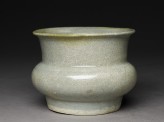 Greenware jar in the style of Guan ware (EA1956.1352)
Greenware jar in the style of Guan ware (EA1956.1352)
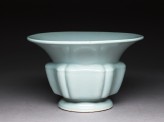 Jardiniere with green glaze (EA1956.3931)
Jardiniere with green glaze (EA1956.3931)
 Vase in the form of an ancient bronze vessel (EA1956.3954)
Vase in the form of an ancient bronze vessel (EA1956.3954)
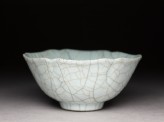 Bowl with crackled glaze in the style of Ge ware (EA1956.3955)
Bowl with crackled glaze in the style of Ge ware (EA1956.3955)
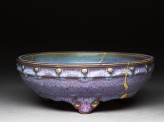 Bulb bowl with purple and blue glazes (EAX.1549)
Bulb bowl with purple and blue glazes (EAX.1549)
 Lacquered box with auspicious symbols (EA1964.170)
Lacquered box with auspicious symbols (EA1964.170)
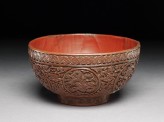 Lacquer bowl with dragons (EA1966.82)
Lacquer bowl with dragons (EA1966.82)
 Lacquered stem cup with silver lining (EA1965.4)
Lacquered stem cup with silver lining (EA1965.4)
 Blue-and-white bowl with lotus scrolls (EAX.1389)
Blue-and-white bowl with lotus scrolls (EAX.1389)
 Vase with dragons and clouds (EA1971.37)
Vase with dragons and clouds (EA1971.37)
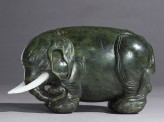 Jade figure of an elephant (EA1967.145)
Jade figure of an elephant (EA1967.145)
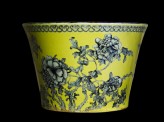 Jardiniere with grisaille floral decoration (EA2009.37)
Jardiniere with grisaille floral decoration (EA2009.37)
 Square vase with flowers and figures (EA1966.237)
Square vase with flowers and figures (EA1966.237)
 Vase in the form of an ancient ritual vessel (EAX.3998)
Vase in the form of an ancient ritual vessel (EAX.3998)
 Vessel in the form of two rams (EAX.3718)
Vessel in the form of two rams (EAX.3718)
 Bronze vase in the form of an ancient hu vessel (EAX.5027)
Bronze vase in the form of an ancient hu vessel (EAX.5027)
 Vase with violet-blue glaze (EAX.1904)
Vase with violet-blue glaze (EAX.1904)
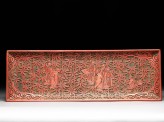 Pen tray depicting the Seven Sages of the Bamboo Grove (EA1964.171)
Pen tray depicting the Seven Sages of the Bamboo Grove (EA1964.171)
 Brush pot with Su Shi's poem Red Cliff (EA2009.38)
Brush pot with Su Shi's poem Red Cliff (EA2009.38)
 Vase with insects and flowers (EA2009.39.a)
Vase with insects and flowers (EA2009.39.a)
 Vase with insects and flowers (EA2009.39.b)
Vase with insects and flowers (EA2009.39.b)
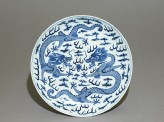 Blue-and-white dish with dragons chasing a flaming pearl (EA1967.177)
Blue-and-white dish with dragons chasing a flaming pearl (EA1967.177)
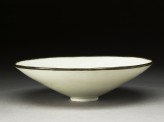 White ware dish with floral decoration (EAX.1179)
White ware dish with floral decoration (EAX.1179)
 Ivory seal with dragon (EA1970.69)
Ivory seal with dragon (EA1970.69)
 Vase with archaistic decoration (EAX.5226)
Vase with archaistic decoration (EAX.5226)
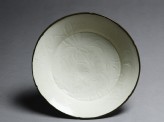 White ware dish with lotus decoration (EA1989.193)
White ware dish with lotus decoration (EA1989.193)
 Blue-and-white jardiniere in the form of an incense bowl (EA1987.2)
Blue-and-white jardiniere in the form of an incense bowl (EA1987.2)
 Blue-and-white dish with figures in a landscape (EA1986.5)
Blue-and-white dish with figures in a landscape (EA1986.5)
 Blue-and-white bowl with lotus scrolls (EAX.1409)
Blue-and-white bowl with lotus scrolls (EAX.1409)
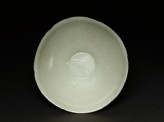 White ware dish with lotus decoration (EA1980.393)
White ware dish with lotus decoration (EA1980.393)
 Rhinoceros horn libation cup with trees and pavilions (EA1957.95)
Rhinoceros horn libation cup with trees and pavilions (EA1957.95)
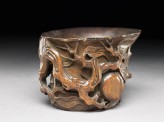 Bamboo cup with peach branches (EAX.5284)
Bamboo cup with peach branches (EAX.5284)
 Brush pot in the form of a bamboo stem (LI1079.2)
Brush pot in the form of a bamboo stem (LI1079.2)
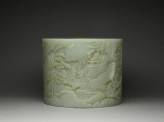 Jade brush pot with a mountain landscape (EA1984.625)
Jade brush pot with a mountain landscape (EA1984.625)
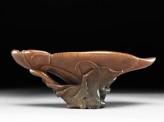 Rhinoceros horn libation cup in the form of a lotus (EA1957.94)
Rhinoceros horn libation cup in the form of a lotus (EA1957.94)
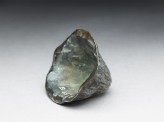 Bronze cup or fitting in the form of a rhinoceros horn or lotus leaf (EAX.5187)
Bronze cup or fitting in the form of a rhinoceros horn or lotus leaf (EAX.5187)
 Rhinoceros horn libation cup with bronze-style decoration (EAX.5287)
Rhinoceros horn libation cup with bronze-style decoration (EAX.5287)
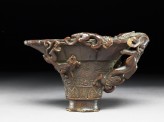 Rhinoceros horn libation cup with bronze-style decoration (EA1957.98)
Rhinoceros horn libation cup with bronze-style decoration (EA1957.98)
Notice
Objects may have since been removed or replaced from a gallery. Click into an individual object record to confirm whether or not an object is currently on display. Our object location data is usually updated on a monthly basis, so contact the Jameel Study Centre if you are planning to visit the museum to see a particular Eastern Art object.
© 2013 University of Oxford - Ashmolean Museum

